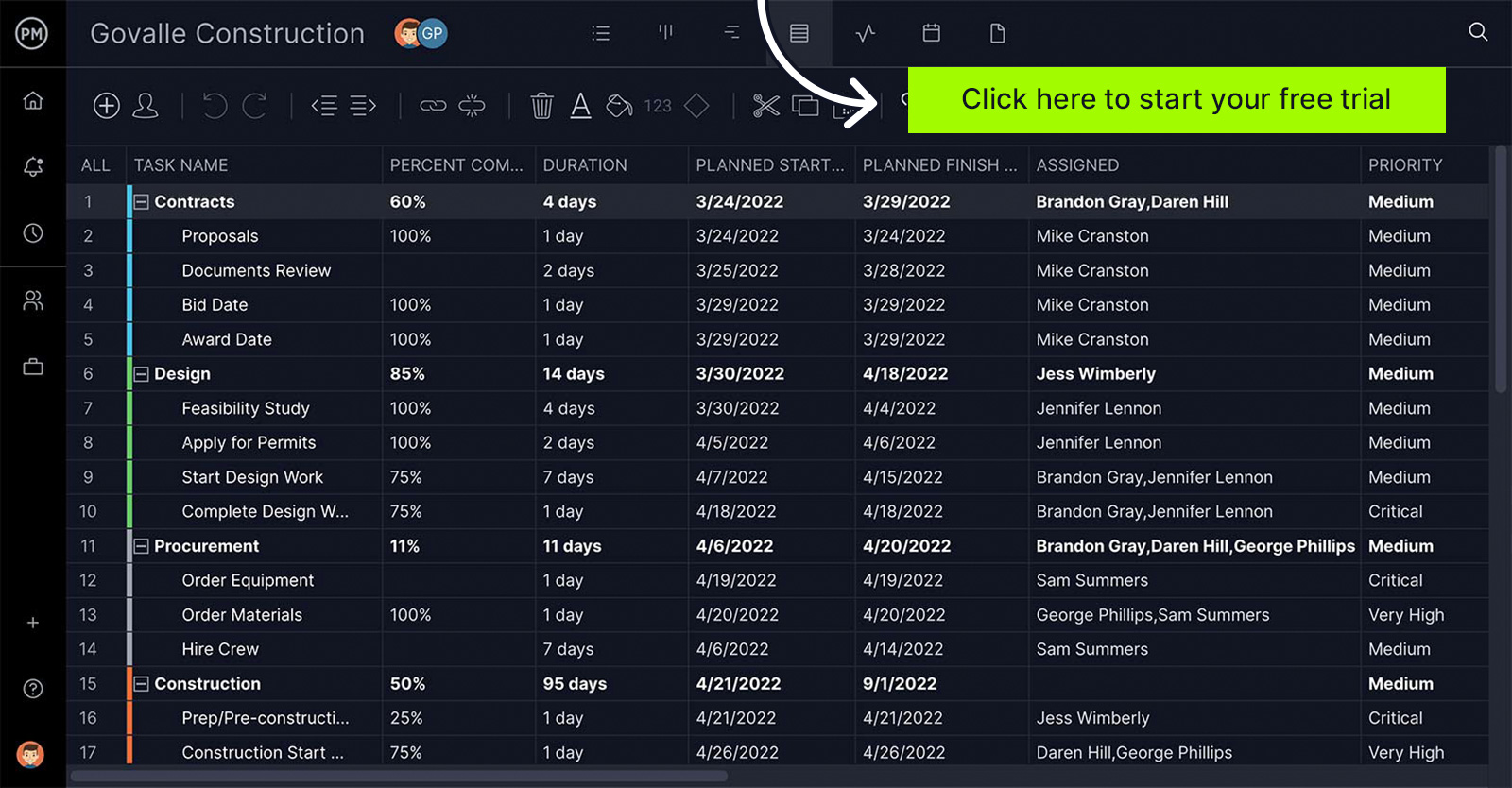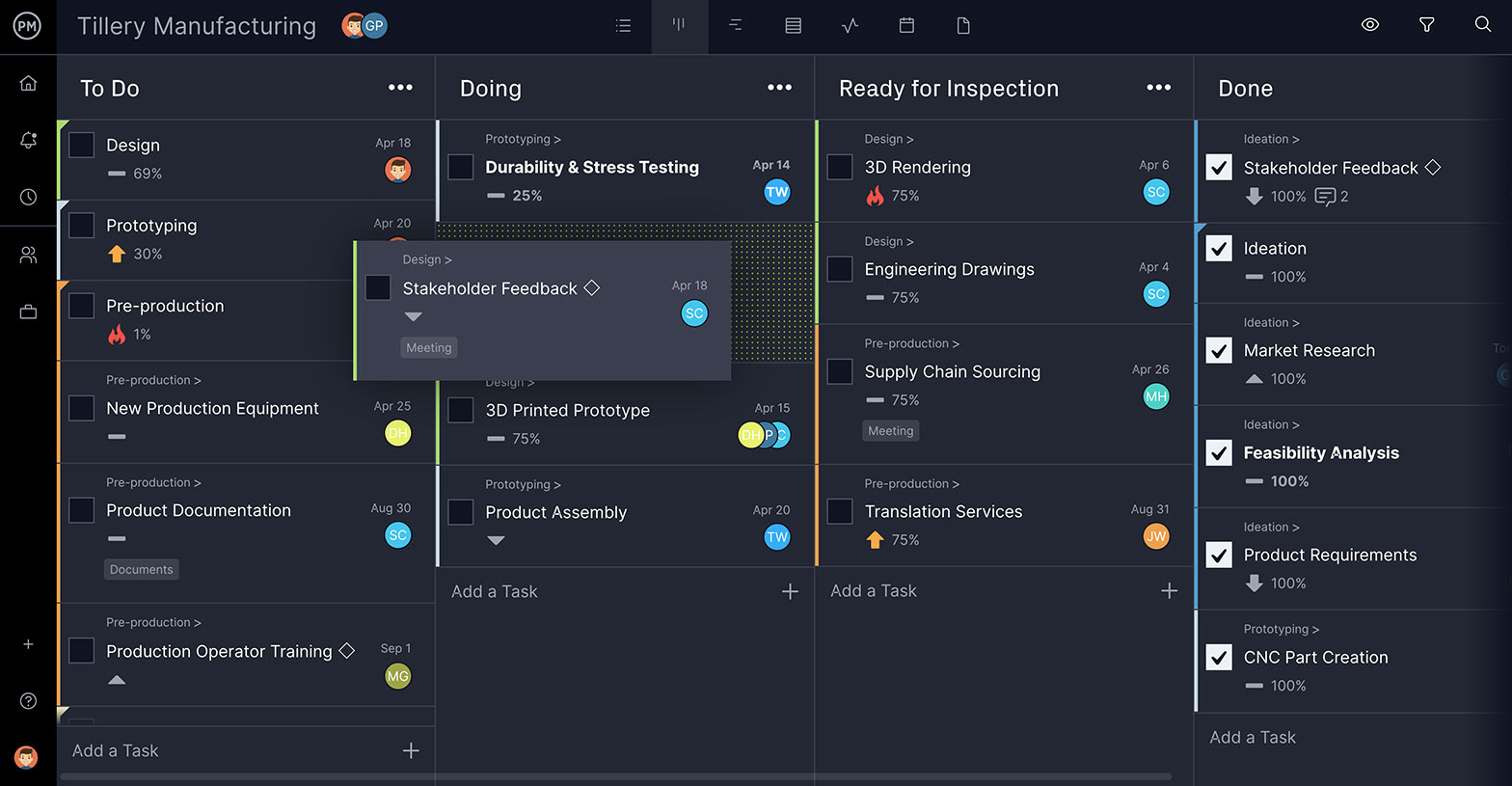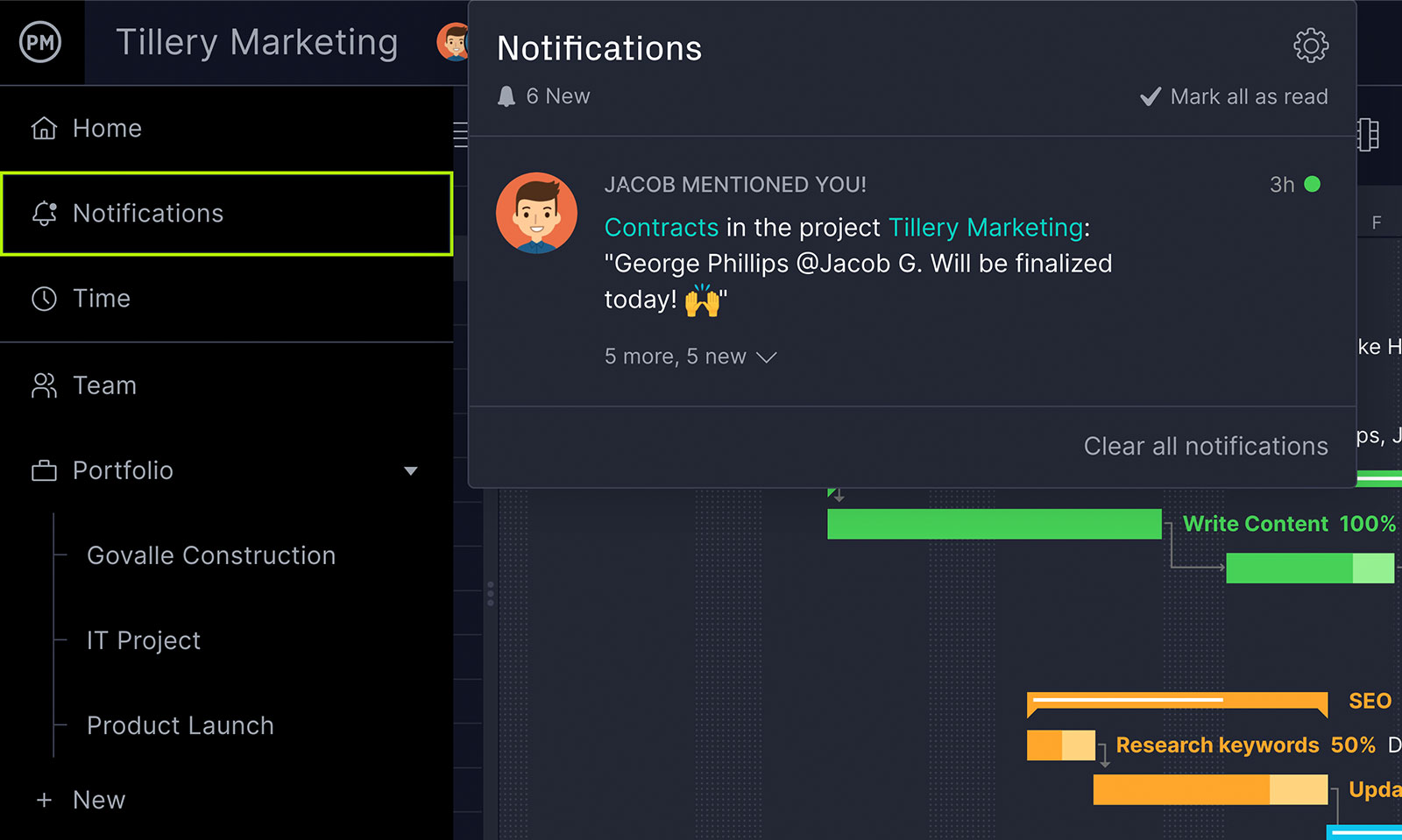There are plenty of well-known project management solutions and many more lesser-known software products on the market. All of them tackle at least one aspect of managing a project, while some claim a holistic approach to project management.
Choosing the best project management software can be difficult. Let’s look at two of the top choices available in the market: Smartsheet and ProjectManager. Both claim to help you manage your project, but which one delivers the goods? Let’s compare them and see which is the best option for your needs.
What Is Smartsheet?
Smartsheet is a work management software with the aim to get teams to collaborate. This cloud-based tool has features to complement that, such as assigning tasks, tracking progress, calendars to capture important dates and document-sharing capabilities.
Its simple interface looks like a spreadsheet, with rows and columns that can be sorted. If the information on the spreadsheet has dates, it can be viewed on the calendar as well. Files can be attached to the rows on the spreadsheet.
Related: Best Smartsheet Alternatives
Because collaboration is the main thrust of Smartsheet, teams can dialogue and stay in contact with one another no matter where they are. They are notified when a new Smartsheet is created or anything is updated. Also, as information is updated on one Smartsheet it is automatically updated throughout the software.
What Is ProjectManager?
ProjectManager is a project management software that organizes tasks, teams and projects. It’s a cloud-based software that facilitates not only collaboration but also insightful decision-making because of the access to real-time data.
Created by project managers for project managers and their teams, it offers a suite of features that address every phase of a project. Planning, monitoring, reporting as well as task and resource management are covered to help teams work as productively as possible.
There are collaborative tools that connect teams and allow stakeholders, subcontractors and vendors alike to have access to the project. Security features limit access and give those outside the ability to view but not edit. This keeps everyone in the loop while preventing accidental changes that could sideline the project.
Smartsheet Features
Smartsheet focuses primarily on Excel-style sheets with an emphasis on collaboration between teammates. The following is a look at Smartsheet’s features:
- Reports: Get data and project information for one or many sheets, then filter to dive down into the specifics you want.
- Dashboard: Create a dashboard to view key metrics, updated in real-time.
- Gantt Charts: Chart your project on a timeline that shows tasks, dependencies and milestones.
- Cards: See tasks as cards to visually organize workflow across different lanes and get transparency into the work process.
- Calendars: Collect important dates from your sheet on a calendar, which can be synced with Google Calendars.
ProjectManager Features
ProjectManager has features that address every phase of the project, from initiation to closure. Let’s take a look at its offerings:
- Reports: One-click reports on project and portfolio status, timesheets, workload and much more. All reports can be shared and filtered to show only the data you want to see.
- Dashboard: No need to configure the dashboard, it’s already embedded in the tool, giving you real-time data on costs, time and more for a high-level view of your progress and performance.
- Gantt Chart: View the Gantt chart or just the sheet view, which removes the timeline to show more columns. Fully customizable, links dependent tasks, sets milestones, filters for critical path, set a baseline to compare planned against actual progress.
- Kanban Boards: Get transparency into your process and reallocate resources to keep teams from being blocked. The board view breaks up your production into columns. Tasks are represented by cards that drag and drop across the board. Teams can manage their backlog and plan sprints.
- List View: More than a to-do list, the list view organizes tasks, which can be filtered by priority, assignee, project and more. See the percentage completed for each task in real-time, add subtasks and more.
- Calendar View: Capture important dates and view your project on a calendar grid. Includes tasks, due dates, duration and assignee. The calendar has the same functionality as other project views, such as percentage complete, attachments, comments and more.
- Resource Management: Keep your team’s workload balanced with a workload chart that shows allocation. Reallocate work right from the page. Set workdays, holidays and PTO. Get visibility into your team’s availability from any project view.
- Time Tracking: Timesheets, dashboards and reports all work to give managers insight on how long teams are working on their tasks and more.
Smartsheet Pricing
Smartsheet has a 30-day free trial that has a limited amount of features, as well as several tiers of paid subscription plans:
- Pro: This plan is $7 per user each month when paid annually and has a 10-user maxiumum.
- Business: This plan costs $25 per user each month when billed annually with a minimum of 3 users.
- Enterprise: This plan requires speaking to a salesperson.
ProjectManager Pricing
ProjectManager is a subscription-based tool with several different ways to get access to its features, including a free 30-day trial. Those membership tiers are as follows:
- Team: This plan allows for unlimited users, $13 per user, per month annually.
- Business: This plan allows for unlimited users, $24 per user, per month annually.
- Enterprise: This plan requires that you work out terms with sales.
Pros and Cons of Smartsheet
Yes, you can manage a project in Smartsheet. That doesn’t mean you’ll want to. It all depends on what’s important to you and what’s not. The truth is that Smartsheet does a fine job of project management using a spreadsheet interface, but there are areas in which it’s not the ideal tool.
Pros of Using Smartsheet
- Collaboration: Collaboration is Smartsheet’s biggest selling point. The software facilitates collaboration through file sharing, commenting on tasks and more. This provides transparency and keeps everyone working on the project in sync, whether they’re working in the same office or remotely.
- Multiple Views: Though it has a sheet in its name, there are more than mere spreadsheets to attract users. These spreadsheets do more than your average Excel variety. You can view your work how you want as a spreadsheet, calendar, Gantt chart or card view.
- Reporting: Any project management tool worth its name will have reporting and analytic features and with this tool, you get reports for finding trends, avoiding issues in a project and getting the big-picture view. Enterprise and Premier editions get data protection, as well as the ability of administrators to restrict access to those they don’t want to have full use of the tool.
Cons of Using Smartsheet
- Not User-Friendly: One of the biggest disadvantages of Smartsheet is that it is hard to use, especially if you’re new to the tool. It’s not a user-friendly interface, which will frustrate users who want to get analytics. The data is collected in a spreadsheet, which doesn’t make scanning the information easy unless you generate a report.
- Limited Tracking: There is tracking, but it’s limited. There are common actions that show up in the activity log, such as who viewed what spreadsheet, report or dashboard. It will also show what’s been shared, but there’s no in-depth tracking from day to day, such as the basic component of all project management: the status report. What you can track is often time-consuming, too.
- Not Flexible: Project management has a number of different approaches or methodologies and Smartsheet is not ideal for some. The cards mimic kanban boards and should be a good fit for agile or hybrid teams, but these teams will find that the functionality they’re used to is absent from the tool. That’s because, regardless of its multiple views, Smartsheet is really a spreadsheet with extra functions glued on top of that old-fashioned tool.
- Tracking is a Premium: While Smartsheet does offer time-tracking, budgeting and resource management those features are going to cost you. They require purchasing companion software, which pushes up the baseline price for the tool.
- Everything is a Premium: Its basic pricing can be a turn-off, too. The standard price seems as if it’s a deal, but then you’re not getting all the bells and whistles in that subscription. If you want to use all the features that Smartsheet is promoting, it’ll cost you; and that price will quickly not be as competitive as it first seemed compared to other similar project management software on the market.
ProjectManager is the Best Smartsheet Alternative
It’s no contest. ProjectManager offers all the features that Smartsheet has and adds ease of use, time tracking and a dedicated account manager. If you don’t have the time to spend learning a complex project management tool, your budget is not open-ended and you want all the features you need rolled into one dynamic package, then you’re probably not going to be satisfied with Smartsheet.
ProjectManager is award-winning software that organizes your tasks, teams and projects without the hassles. It provides you with the security you demand to safeguard your data, such as two-factor authentication and single sign-on. There are multiple project views that share data to keep everyone on the same page and working with the tools they prefer.
If you’re using Smartsheet or are interested in it, then you want a spreadsheet and we have our project sheet view. Here you can see your project in customizable columns and rows laid out clearly and simply on a grid. Use one of our industry-specific templates to start, or import your spreadsheet and all your data shows up as you formatted it. You can set tasks, subtasks, dependencies and more.

The project sheet view is just like our Gantt chart view, which has all the same functionality with the addition of a visual timeline, where dependent tasks are linked to avoiding bottlenecks, milestones are set to break up larger projects into more manageable bits and you can instantly calculate the critical path and set a baseline to compare your actual progress when you execute the project.

Agile and hybrid teams get all the functionality they want on our kanban board view. They can manage their backlog and plan sprints together. Managers get transparency into their work and can quickly reallocate resources to meet their capacity and keep the workflow running smoothly.

Our cloud-based tool makes it easier for teams to work more productively together. They can comment at the task level, tag other team members to bring them into the conversation, attach files and more. Managers can describe the task, set deadlines and tags. As teams update their statuses that data is instantly fed into our tool helping managers make more informed decisions.

Unlike Smartsheet, we have budget, resource management and time-tracking tools embedded in our software. Create budgets, balance your team’s workload and track nonhuman resources. Use secure timesheets to streamline the payroll process and track the time your team is spending on their tasks, which also helps with scheduling. Smartsheet doesn’t have any of these functionalities.
Related Content
- What Is Smartsheet? Uses, Features and Pricing
- Best Smartsheet Alternatives: Free & Paid Options Ranked
- Asana vs ProjectManager: Which Software is Better?
- Monday.com vs. ProjectManager: Which Is Best for Project Management?
ProjectManager does everything Smartsheet does and more for less. Plan, monitor and report on your project while giving your team a collaborative platform to work better together. Get all this and the security to keep your data safe. Join the tens of thousands of teams who have already used our tool to run successful projects for organizations such as NASA, the Postal Service and the Bank of America. Try the software for free today.

